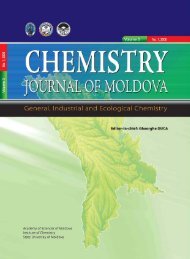2011, nr. 3 - Academia de ÅtiinÅ£e a Moldovei
2011, nr. 3 - Academia de ÅtiinÅ£e a Moldovei
2011, nr. 3 - Academia de ÅtiinÅ£e a Moldovei
Create successful ePaper yourself
Turn your PDF publications into a flip-book with our unique Google optimized e-Paper software.
3547. Fontbonne A., Charli A. The Insulin resistanceSyndrome and the Paris Prospective Study. CardiovascularRisk Factors, 1993, № 3.8. Zimmet P., Sergentson S. The epi<strong>de</strong>miolology ofdiabete mellitus and its relationship with cardiovasculardisease. In: New aspect in diabetes. P.J. Lefebvre &E.Standl (Eds), <strong>de</strong> Gruyer, Berlin, 1992.9. Borona E., Kiechl S., Willeit J. Insulinoresistance:prospective results from the Bruneck Study. In: Diabetes,1998, vol. 47.10. Barker D. J. P., Hales С. К, Fall С. Н. D. etal. Type 2 (non-insulin-<strong>de</strong>pen<strong>de</strong>nt) diabetes mellitus,hypertension and hyperlipidaemia (syndrome X): relationto reduced fetal growth. In: Diabetologia, 1993, vol.36.11. kso M., Sarlund H., Salonen R. et al. Asymptomaticatherosclerosis and insulin resistance. In: Arterioscler.Thromb., 1991, vol. 11.12. Lamarche B., Cantin B., Mauriege P. etal. Variability in the risk of ischemic heart diseaseassociatedwith mo<strong>de</strong>rate hypertriglyceri<strong>de</strong>mia. QuebecCardiovascular Study. In: Circulation,1999, vol. 100(suppl.).13. Karelis A. D., St-Pierre D. H, Conus F. et al.Metabolic and body composition factors in sub groupsof obesity: what do we know? In: J. Clin. Endocrinol.Metab., 2004, vol. 89.14. World Health Organization (WHO). Defi nition,diagnosis and classifi cation of diabetes mellitusand its complications. Report of a WHO Consultation,part 1: Diagnosis and classifi cation of diabetesmellitus. Geneva, Switzerland, WHO, 1999.RezumatPatologia cardiovasculară ocupă un loc dominant înstructura morbidităţii. O influenţă negativă asupra vieţiiomului o are ritmul înalt al progresului ştiinţifico-tehnologic,care reduce radical nivelul <strong>de</strong> activitate fizică, majoreazăvaloarea energetică a produselor alimentare şi stresulcronic. Ca răspuns la aceste schimbări în viaţa societăţii,are loc creşterea numărului <strong>de</strong> oameni cu modificări patologiceale metabolismului la diferite nivele. Acestea aufost repartizate într-un grup <strong>de</strong> patologii numite „metabolice”,care favorizează <strong>de</strong>zvoltarea aterosclerozei. În acestBuletinul AŞMarticol sunt reflectate aspectele epi<strong>de</strong>miologice ale sindromuluimetabolic (SM). În particular, în copilărie şi adolescenţăaceste modificări sunt puţin observate (hipertensiuneneînsemnată, masa corporală crescută, dislipi<strong>de</strong>mie), darulterior provoacă leziuni aterosclerotice ale organelor şisistemelor.SummaryCardiovascular diseases are becoming the leadingcause of morbidity and mortality. Scientific andtechnological progress has had a negative impact onhuman life, by limiting physical activity while allowinghigh morbility, by increasing the caloric value of foodsand changing eating habits and by causing cronic stress.Among the natural consequences of scientific andtechnological progr ess is the great number of peoplesuffering from metabolic disturbances, which has led tothe separation of a special group of “metabolic” diseasesrezulting in accelerated <strong>de</strong>velopment of atherosclerosis.Here we review the evi<strong>de</strong>nce for the epi<strong>de</strong>mic character ofmetabolic syndrome inci<strong>de</strong>nce. In particular, the signs ofmetabolic syndrome in children and adolescents, such asmild blood pressure alevation, small increase of body massand dyslipi<strong>de</strong>mia, may seem virtually harmless, bat leterlead to atherosclerotic lesions.РезюмеСердечно-сосудистая патология занимает доминирующееместо в структуре заболеваемости. Негативноевлияние на человеческую жизнь имеет чрезвычайнобыстрое развитие научно-технического прогресса,который снизил уровень физической активности, увеличивэнергетическую ценность продуктов питания ихронический стресс. В ответ на эти изменения, растетчисло людей с патологическими изменениями в обменевеществ на различных уровнях, которые в своюочередь были разделены на группы «метаболических»заболеваний, что в первую очередь способствует развитиюатеросклероза. В этой статье описаны эпидемиологическиеаспекты метаболического синдрома (МС).В частности, в детском и подростковом возрасте этиизменения наблюдаются реже (незначительная гипертензия,повышенная масса тела, дислипидемия), но этипризнаки являются предвестниками и причинами атеросклеротическихпоражений органов и систем.
















